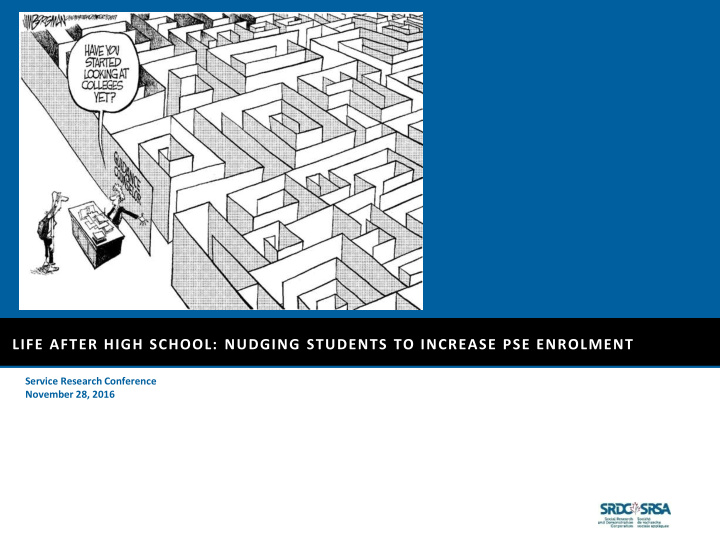



LIFE AFTER HIGH SCHOOL: NUDGING STUDENTS TO INCREASE PSE ENROLMENT Service Research Conference November 28, 2016
Overview Life After High School is one of several SRDC projects seeking to find ways to: increase supply of skilled workers to future Canadian economy and promote inclusion for less advantaged youth Cluster randomized experiments tested variants of a “nudge” approach to increase postsecondary application and enrolment among Grade 12 students from low-transition high schools in BC in 2010-11, Ontario in 2011-12 (Phase 1) and 2013-14 (Phase 2). The program seeks to change default behaviours such that: Every Grade 12 student completes a college or university application Every Grade 12 student completes a student financial aid application 2
Many steps and hurdles along the way can discourage postsecondary access Making application to college or university a default Grade 12 activity to: • overcome inertia ( status quo bias ) and complexity bias that hold some students back in making decisions about their future • increase the salience of postsecondary education as a destination all students can aspire to ( bandwagon effect ) • accelerate students’ options to take up postsecondary by increasing options open to them on the way out of high school. In trying to decide what to do next, decision to go to PSE only involves deciding to show up ( availability heuristic ) 10
Three hours of workshops during class time, in front of a computer Workshop 1: Late Oct to mid-Nov Introduces LAHS, creates LAHS student accounts Students browse PSE programs and calculate financial aid eligibility; map out a budget Workshop 2: Mid-Nov to mid-Dec Prepare and submit real college or university applications Application fees [$15-$135] paid Workshop 3: April to May Prepare student financial aid applications 13
From theory to application 3 workshops conducted in classroom during Grade 12 to make preparing for PSE matter and easier to do Half the 86 schools act as ‘controls’ in the experiment 12
ON GRADE 12 COHORT OF 2011-12 6
All “Grade 12 students” should participate…. … but this was hard to achieve, e.g. Ontario Phase 1 16
Life After High School raised application rates significantly 23
Life After High School raised PSE registration rates significantly 24
Life After High School raised application and registration rates for high school graduates 25
On average, each school had 24 more students receiving an offer of a place in college, and 9 more taking it up Counts of students Without LAHS LAHS added Number of Grade 12 263.9 0.0 Number of Graduates 161.8 0.0 Applicants to College 66.4 +25.2 Offers of acceptance 60.2 +23.5 Applied, no offer 6.3 +1.6 Took offer 46.1 +8.6 Counsellor: “I think the Pay for Free option and the forced workshop attendance allowed some students the opportunity to go to PSE. Many students had planned to come back for year 5 but then were surprised when they received an acceptance to PSE.” 26
Summary of findings ON Phase I • Large impacts (13.5 percentage points) on postsecondary applications (17.6 percentage points among graduates) • Significant 3.5 percentage point increase (4.9 percentage points among graduates) on registering in PSE • New destination typically community college programs 20
ON GRADE 12 COHORT OF 2013-14 13
Variant program models to find most effective and efficient Workshop No. of Application Facilitators: Program Year program IT fee waiver? external or choice tool schools internal? School BC 2010-11 24 Yes School External chooses School External, ON 2011-12 43 Yes School chooses simplified ON 2013-14 A 7 Yes SRDC External B 4 No SRDC External Existing career 5 Yes External C SRDC+ follow up planning tools E 3 Yes School School 9 No School School F 14
ON application rates to college or university Variant program versus control (Phase 2) 15
Summary of findings ON Phase 2 • Schools with fee waivers saw postsecondary application increase from 40 per cent of all Grade 12 students to close to 60 per cent [levels equivalent to high school graduation rates]. • In schools where fees were not waived, LAHS had no impacts, and sometimes negative impacts, on application and registration rates. • Only where students experienced enhanced online connectivity, extended exposure to external facilitators and one-to-one follow up as needed did postsecondary registrations increase significantly: • University participation up 4 percentage points among those entering Grade 12 with 18 to 21.5 credits. • University participation up 15 percentage points among those entering Grade 12 most prepared to graduate and enroll in postsecondary education. 20
Would LAHS impacts on enrollment be eroded by higher attrition from postsecondary education? BC – No evidence of additional attrition ON Phase I & II – Need to pursue additional tracking analysis for program and control schools students NB FTD – Lower- income students tracked 6 years out of high school 20
Policy lessons Nudging (changing defaults while simplifying processes): • can ensure many more young people get to receive critical information about their future options before leaving high school; • appears able to change the life chances of some of them as a result. There is scope for further improvements to support the program choice process and ease completion of the OSAP application. • Waive or reposition application fees. • Phase I vs Phase II suggests shortfalls in use of existing career planning software to make effective program choices relatively quickly. • Given results from other SRDC experiments on access, more fundamental changes in systems prior to Grade 12 in low-transition schools may further support applications and yield larger registration impacts, e.g. earlier academic preparedness, career development, financial literacy and/or motivation. 18
Recommend
More recommend